
Long-Term Monitoring Of The Geochemistry Of Surface Water And Stream-Sediment Samples From The Upper Pecos River, From The Southern Pecos Wilderness To Brantley Dam, North Of Carlsbad, Eastern New Mexico
February 9, 2001
INTRODUCTION
Water quality of the Pecos River has regional and international concerns as the population in eastern New Mexico increases. Four areas of concern were identified:
- Pecos mine
- Alamitos Canyon mill
- Material from the mine waste pile had been used as fill in the campgrounds and roads north of Terrero
- Lisboa Springs Fish Hatchery (New Mexico Game and Fish Dept)
Reclamation of the campgrounds, roads, and Alamitos Canyon mill site began in the early 1990s and is nearly completed. Reclamation of the Pecos mine began in 1999 and is on going. The Lisboa Springs Fish Hatchery closed, temporarily, in 2000 because the fish were diagnosed with Whirling disease, which is not related to the metals contamination from the Pecos mine.
Since reclamation of the Pecos mine, Alamitos Canyon mill, and campgrounds began in 1990-1991, there has been continued monitoring of base metals and trace element concentrations in stream sediments along the Pecos River, extending from the upper Pecos River to below Brantley Dam, north of Carlsbad. In September 1992, the New Mexico Bureau of Mines and Mineral Resources (NMBMMR) personel sampled and analyzed water and stream sediments from the Pecos River at sites near the Pecos Wilderness boundary southward to below Brantley Lake, north of Carlsbad (McLemore et al., 1993). Subsequently, the U.S. Bureau of Reclamation, in cooperation with the New Mexico Institute of Mining and Technology (NMIMT) and NMBMMR, initiated a three-year multi-disciplinary study of the headwaters of the Pecos River (Pecos Wilderness boundary to Villanueva) in order to identify and prioritize point and non-point sources of contamination so that measures can be taken to protect water supplies for municipal, irrigation, and recreational use and to protect wildlife habitat (Brandvold et al., 1995; Brandvold and McLemore, 1999; McLemore et al., 1995a, b; Popp et al., 1996). In September 1992, 1996, and June 2000, the NMBMMR resampled water and stream sediments from the entire Pecos River from the Pecos Wilderness southward to below Brantley Lake. This report presents a summary of the first nine sampling trips in 1992-1995 (McLemore et al., 1993; Popp et al., 1996) and presents new data from the sampling trips in 1996 and 2000.
STUDY AREA
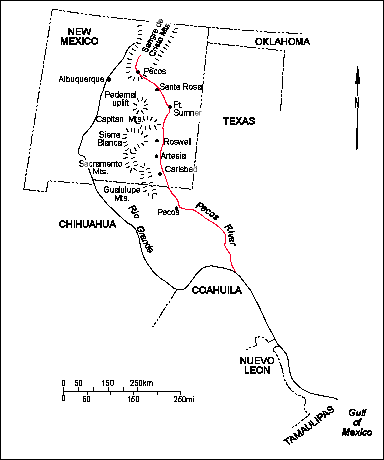
The study area covers the southern Pecos Wilderness to south of Brantley Lake and includes many tributaries and the main stem of the Pecos River (Fig. 1). The headwaters of the Pecos River are in the southern Sangre de Cristo Mountains, with additional drainages from the Pedernal uplift, Capitan Mountains, Sierra Blanca, and Guadalupe Mountains. Elevations range 1000 to over 3600 m. The river flows southward through the towns and cities of Pecos, Santa Rosa, Fort Sumner, Roswell, Artesia and Carlsbad into west Texas and finally enters the Rio Grande at the international border with Coahuila, Mexico. The Pecos River flows through the Santa Fe National Forest and the Pecos National Historical Park (U.S. National Park Service) and several state parks. Water from the Pecos River is stored in three main reservoirs: Santa Rosa, Sumner, and Brantley Lake. Eastern New Mexico is predominantly a rural agricultural area, but the larger cities have some light industry. Petroleum and potash production is important in southeastern New Mexico near Artesia and Carlsbad. There is currently no metals mining within the Pecos drainage basin.
REGIONAL GEOLOGY
The geology of the Pecos River drainage basin is complex with rocks ranging in age from Proterozoic to recent. Lithologies are likewise diverse, ranging from metamorphic volcanic rocks to granites to syenites to shales, limestones, and sandstones (Fig. 2; Anderson et al., 1994). Proterozoic rocks crop out along the upper Pecos River and several tributaries north of Pecos. The oldest rocks are mafic metamorphic and volcaniclastic rocks that comprise the Pecos greenstone belt. The most abundant Proterozoic rocks are the plutonic rocks that consist of granite, tonalite-trondjemite, gabbro, diabase, and ultramafic rocks. Overlying sedimentary rocks consist of Mississippian limestone, sandstone, and shale of the Arroyo Penasco Group (Espiritu Santo and Terrero Formations) and unconformably overlie the Proterozoic rocks. Pennsylvanian siltstones, sandstones, shales, thin coals, and limestones overlie the Mississippian and, locally Proterozoic rocks in the Pecos River area. The Pennsylvanian-Permian rocks consist of the Magdalena Group and the Sangre de Cristo Formation. Permian siltstones, limestones, and sandstones overlie the Pennsylvanian-Permian rocks and consist of the Yeso, San Andres, and Bernal Formations. Triassic sandstones crop out in the area south of Pecos and consist of the Santa Rosa Sandstone. Permian evaporates that comprise the Permian Basin section crop out south of Roswell. Quaternary rocks are found throughout the area and consist of Pleistocene to recent alluvial, terrace, and floodplain deposits.
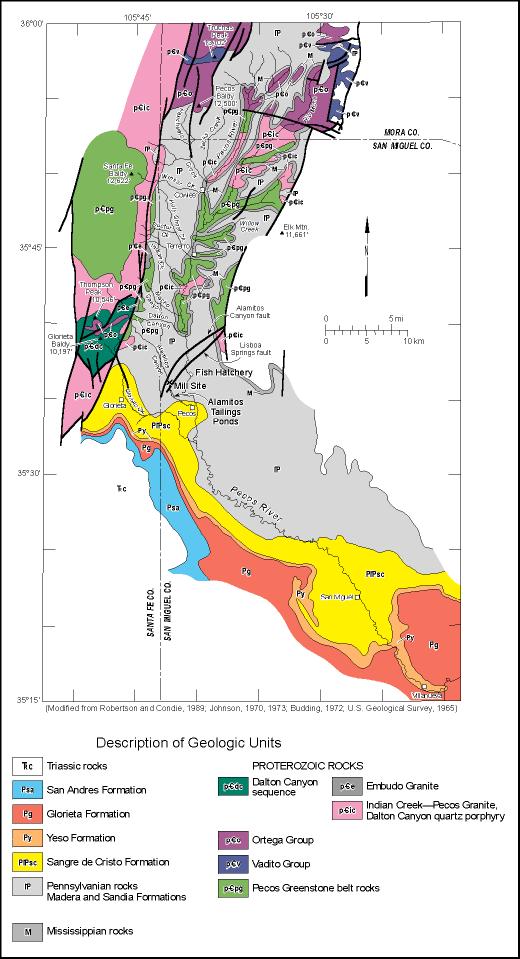
(Anderson, 1994; New Mexico Geological Society, 1982).
MINING HISTORY
- Mining began in the Sangre de Cristo Mountains in the late 1880s (Fig. 3, 4).
- The Pecos mine is a volcanogenic massive-sulfide deposit containing Pb, Zn, Cu, Ag and Au.
- The Pecos mine is largest of these deposits in New Mexico.
- The Pecos mine produced during 1902-1904, 1927-1939, and 1943-1944.
- The ore was shipped 18 km SW by aerial tram to the Alamitos Canyon mill where the mill tailings were deposited along Alamitos Canyon (Fig. 4).
- The Pecos mine was the largest lead and zinc producer in New Mexico from 1927 to 1939.
- Production from other deposits in the southern Sangre de Cristo Mountains is minor and insignificant (Fig. 3).
- The Pecos mine generated ~ 70,000 m3 of waste rock, which is a source of acidic drainage and a point source of Pb, Zn, Cu, Se, Cd, and Cr.
- The waste rock was used as fill in campgrounds and roads north of Terrero.
- Reclamation began in the early 1990s and continues today.
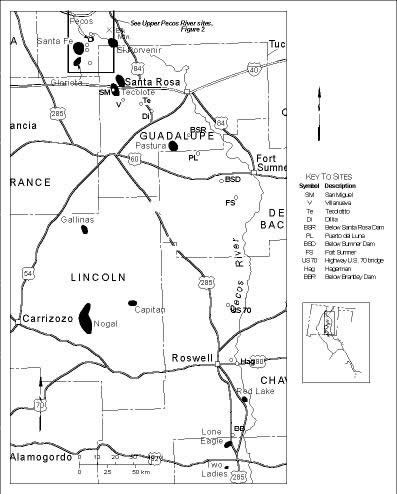
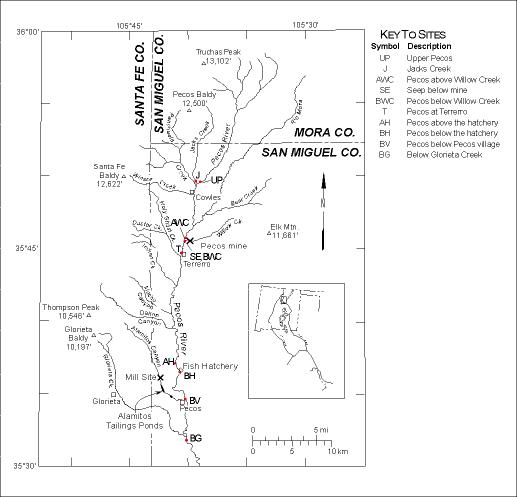
DESCRIPTION OF THE PECOS MINE SITE
The waste rock generated during mining activities was piled at the Pecos mine site and consists of several dumps within an area of approximately 7.7 ha (Fig. 5). Estimates of the volume of waste rock vary from 66,151 to 72,630 m3 of material. The waste pile is underlain by a layer of colluvial materials, less than 5 m thick and consisting of clay and sedimentary rock fragments (limestone, shale, sandstones; Johnson and Deeds, 1995 a, b). Mineralogically and chemically the mine waste pile is very heterogeneous.
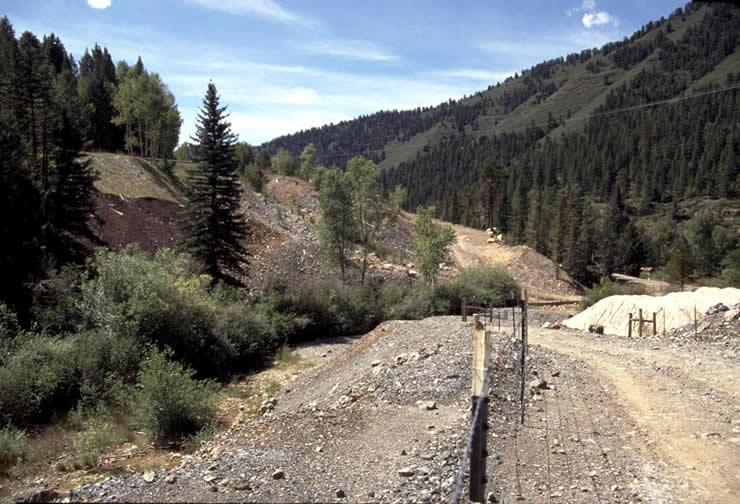
Mineralogy of the ore deposits at the Pecos mine,
in order of perceived abundance:
(Stott, 1931; Krieger, 1932b;
Northrop, 1959; Fulp, 1982; Fulp and Rensaw, 1985; Popp et al.,
1996).
* Found on mine waste dump at Pecos mine (Popp et al.,
1996).
Major Ore Minerals:
- *sphalerite ZnS
- *galena PbS
- *chalcopyrite CuFeS2
Minor Ore Occurrences:
- *bornite Cu5FeS4
- tetrahedrite (Cu,Fe)12Sb4S13
- native gold Au
- argentite Ag2S
- proustite Ag3AsS3
Oxidized Minerals:
- *malachite Cu2CO3(OH)2
- *azurite Cu3(CO3)2(OH)2
- *angelsite PbSO4
- *smithsonite ZnCO3
- *chalcocite Cu2S
- cerussite PbCO3
- *chalcanthite CuSO4 × 5H2O
Selected Gangue Minerals:
- *pyrite FeS2
- *pyrrhotite Fe1-xS
- *quartz SiO2
- *chlorite (complex silicate)
- *actinolite Ca2(Mg,Fe)5Si8O22(OH)2
- *tourmaline (complex silicate)
- *epidote Ca2(Al,Fe)2(Al,Si3,O12)(OH)
- *Fe and Mn oxides
- *arsenopyrite FeAsS
- *biotite K (Mg,Fe)3AlSi3O10(OH)2
- *fluorite CaF2
- *kaolinite Al2Si2O5(OH)4
- *sericite KAl2(AlSi3O10)(OH)2
- *calcite CaCO3
| Element | *Average | *Standard deviation |
*Maximum | *Minimum | *Number of samples | NMBMMR sample of Pecos mine piles (Pecos) |
|---|---|---|---|---|---|---|
| Cu | 1,840 | 1,960 | 7,140 | 40 | 25 | 11,810 |
| Pb | 9,380 | 10,400 | 33,100 | 41.8 | 25 | 238 |
| Zn | 17,330 | 30,600 | 150,000 | 204 | 25 | 31,350 |
| As | 25 | 23 | 101 | 1 | 20 | — |
| Cd | 68 | 136 | 607 | 0.65 | 20 | 7.5 |
| Hg | 0.65 | 0.81 | 2.49 | 0.033 | 10 | <0.10 |
| Ag | 10 | 11 | 32.6 | 0 | 20 | — |
| Al | 13,740 | 9,880 | 27,000 | 23 | 5 | — |
| Fe | 52,650 | 35,120 | 129,150 | 10,960 | 12 | 5.3 |
| Co | 18 | 14 | 59.5 | 3.2 | 13 | — |
| Cr | 18 | 13 | 52.4 | 2.4 | 20 | — |
| Ni | 12 | 6 | 23.3 | 1.7 | 13 | 29 |
Numerous discrete and diffuse seeps occur along the base of the mine waste pile (Fig. 6). The number of seeps and amount of water flow varies according to daily storm events and snowmelt as well as yearly fluctuations in precipitation. During August 1994 many seeps were dry and the total amount of flow was lower than on previous visits in 1992 and 1993. White and brown precipitates or froths are present along the course of the seeps that drain into Willow Creek. X-ray diffraction and chemical analyses (Popp et al., 1996) of the precipitates from the seeps indicate that they are a mixture of Fe, Cu, and Zn sulfates, and Fe and Al oxides and hydroxides including goslarite (ZnSO4·H2O). Chemical analyses of water samples from the seeps indicate a low pH and high total metals.
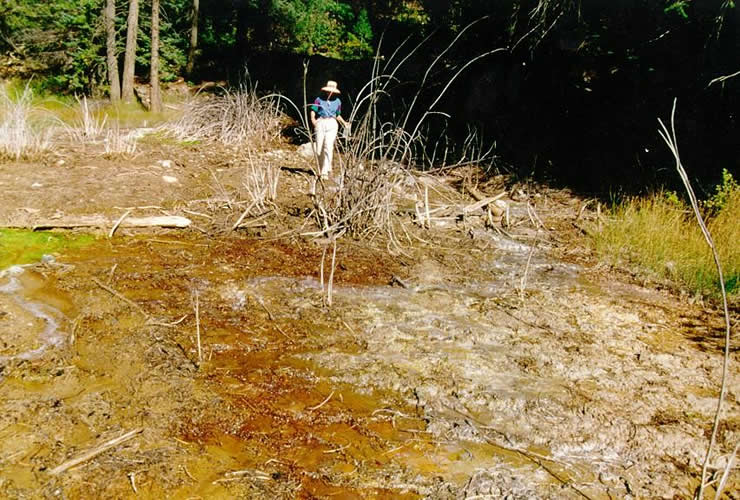
DESCRIPTION OF THE ALAMITOS CANYON MILL SITE
The ore crushed at the mine and then transported by aerial tramway to the Alamitos Canyon mill (El Molino site) 18 km south of the mine (Fig. 4). The sulfide grains entering the mill were as large as 3 mm. A typical analysis of the mill feed was reported at 4.9% Pb, 15.4% Zn, 0.8% Cu, 113 ppm Ag, and 3.4 ppm Au (Bemis, 1932). Mill recoveries were good by the standard of the day although variable (Bemis, 1932). The rejected waste material was conveyed to the tailings pond in Alamitos Canyon and held in place by two earthen dams, 0.7 km and 1.5 km downstream of the mill site.
Today the tailings piles occupy approximately 14 ha in the bottom of Alamitos Canyon (Fig. 7; Sidle et al., 1991). The depth varies from 0 to 20 m and averages 9-12 m. The tailings consist of predominantly sand size material (Sidle et al., 1991). More silt is found in the southern, lower end of the pile than the north end. Higher concentrations of metals are found in the lower end as well. Discharge from the tailings pile enters Alamitos Creek, was acidic before reclamation and contained elevated levels of metals (Sidle et al., 1991; Brandvold et al., 1995). Wet meadows with pockets of water covered some of the tailings. Reclamation is currently underway with construction of a stream channel through the tailings pile and stabilization of the tailings by covering with clay, gravel, and soil (Johnson and Deeds, 1995 a, b).
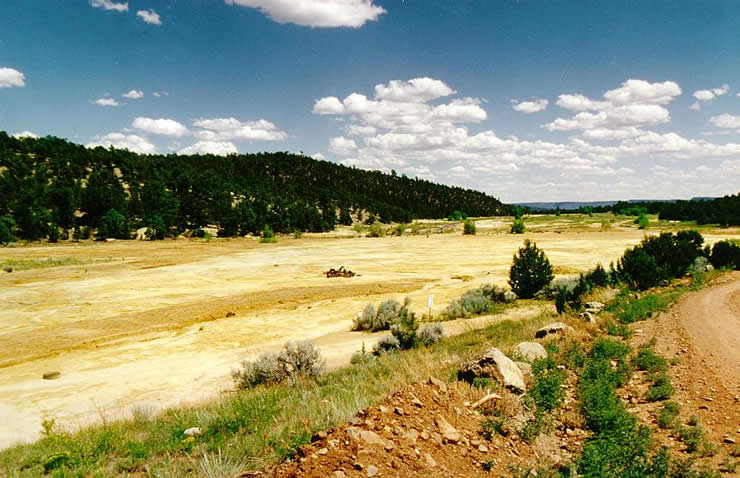
NMBMMR SAMPLING AND MONITORING PLAN
In September 1992, the New Mexico Bureau of Mines and Mineral Resources sampled and analyzed water and stream sediments from the Pecos River at sites near the Pecos Wilderness boundary southward to below Brantley Lake, north of Carlsbad (Fig. 4, 8, 9; McLemore et al., 1993). Subsequently, the U.S. Bureau of Reclamation, in cooperation with the New Mexico Institute of Mining and Technology (NMIMT) and NMBMMR, initiated a three-year multi-disciplinary study of the headwaters of the Pecos River in order to identify and prioritize point and non-point sources of contamination so that measures can be taken to protect water supplies for municipal, irrigation, and recreational use and to protect wildlife habitat (Brandvold et al., 1995; Brandvold and McLemore, 1999; McLemore et al., 1995a, b; Popp et al., 1996). In September 1996 and June 2000, the NMBMMR sampled water and stream sediments from the entire Pecos River from the Pecos Wilderness southward to below Brantley Lake. A report in preparation presents a summary of the first nine sampling trips in 1992-1995 (McLemore et al., 1993; Popp et al., 1996) and presents new data from the sampling trips in 1996 and 2000. The NMBMMR will continue to sample and monitor the metals concentration in water and stream sediment samples of the Pecos River in the future.
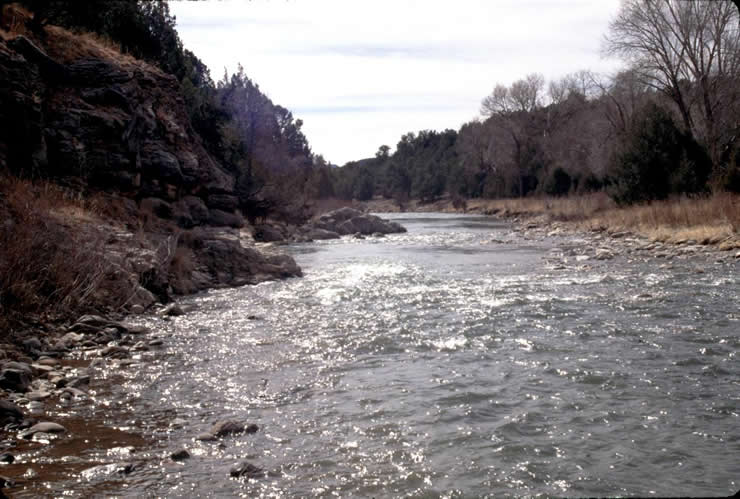

RESULTS
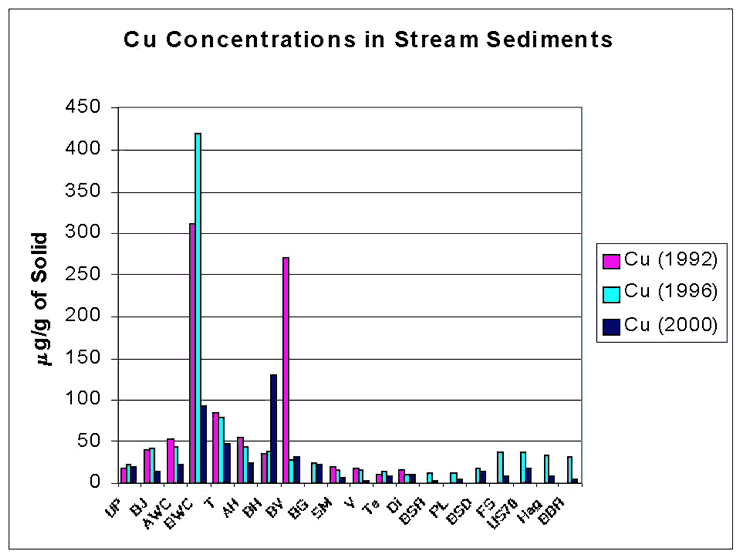
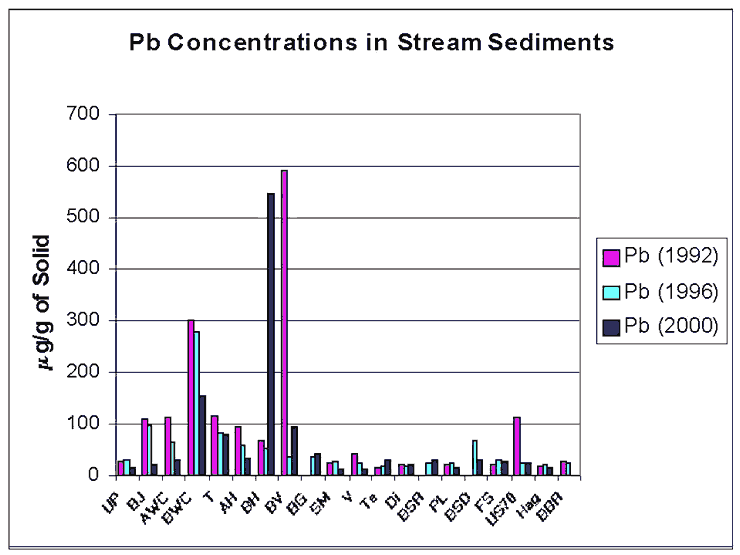
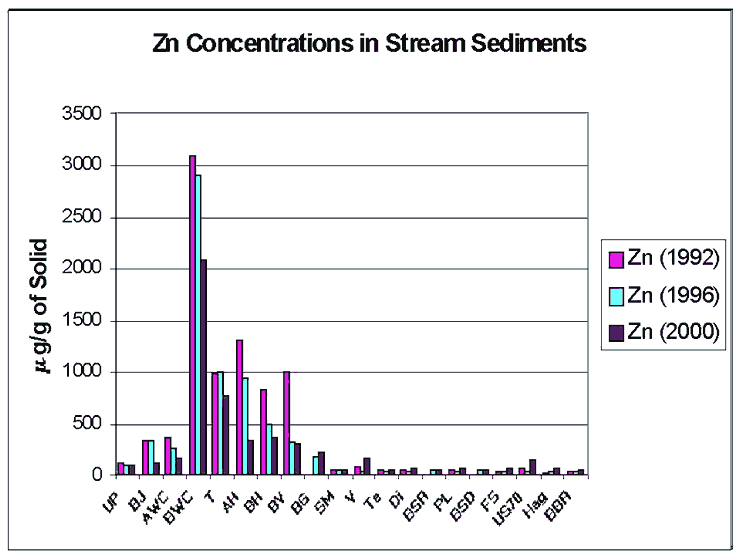
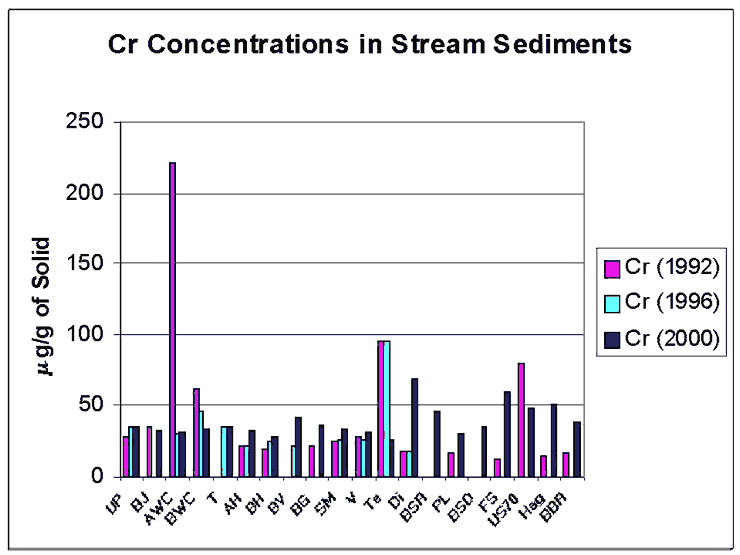
SUMMARY
- Since reclamation of the Pecos mine, Alamitos Canyon mill, and campgrounds began in 1990-1991, Cu, Pb, and Zn concentrations have decreased overall while Cr concentrations have increased slightly.
- The overall metal concentrations have dramatically decreased in stream sediments below Pecos village, mostly due to dilution of sediment downstream.
- Although metal concentrations in the immediate vicinity of the mine have decreased, concentrations remain higher below the Pecos mine than above it, suggesting that metals continue to be eroded and leached from the Pecos mine waste piles.
REFERENCES
- Anderson, O. J., Jones, G. E., and Green, G. N., 1994, Geologic map of New Mexico: New Mexico Bureau of Mines and Mineral Resources, Open-file report 408A, scale 1:1:500,000.
- Anderson, E. C., 1938, The aerial tramway as used at the Pecos mine: unpublished thesis, New Mexico School of Mines, Socorro, 15 pp.
- Armstrong, A. K. and Mamet, B. L., 1990, Stratigraphy facies and paleotectonics of the Mississippian system, Sangre de Cristo Mountains, New Mexico and Colorado and adjacent areas: New Mexico Geological Society, Guidebook to the 41st Field Conference, pp. 241-249.
- Armstrong, A. K. and Mamet, Bl L., 1979, The Mississippian system of north-central New Mexico: New Mexico Geological Society, Guidebook to the 30th field Conference, pp. 201-210.
- Bemis, H. D., 1932, Milling methods and costs at the Pecos concentrator of the American Metal Co., Tererro, New Mexico: U.S. Bureau of Mines, Information Circular 6605, 23 pp.
- Brandvold, L. A. and McLemore, V. T., 1999, A study of the analytical variation of sampling and analysis of stream sediments from mining and milling contaminated areas: Journal of Geochemical Exploration, v. 64, pp. 185-196.
- Brandvold, L.A., McLemore, V.T., Brandvold, D.K., and O’Conner, C., 1995, Distribution and partitioning of copper, lead, and zinc in stream-sediments above and below an abandoned mining and milling area near Pecos, New Mexico, U.S.A.: The Analyst, v. 120, in press.
- Brill, K. G., Jr., 1952, Stratigraphy in the Permo-Pennsylvanian Zeugogeosyncline of Colorado and northern New Mexico: Geological Society of America, Bulletin, v. 63, pp. 809-880.
- Budding, A. J., 1972, Geologic map and sections of the Glorieta quadrangle, Santa Fe County, New Mexico: New Mexico Bureau of Mines and Mineral Resources, Geologic Map 24, 1:24,000.
- Carey, E. A., Brandvold, L. A., and McLemore, V. T., 2001, Base metal and trace element concentrations in stream sediments along the Pecos River, from the southern Pecos Wilderness to Brantley Dam, north of Carlsbad, eastern New Mexico: American Society for Surface Mining and Reclamation, 18th annual meeting, in press
- Codding, D. B., 1983, Precambrian geology of the Rio Mora area, New Mexico: Structural and stratigraphic relations: MS thesis, University of New Mexico, Albuquerque, 128 pp.
- Dixon, R. L. and Seay, M. W., 1979, Pecos project, state of New Mexico, Santa Fe and San Miguel Counties, massive sulfides, copper-lead-zinc-gold-silver: unpublished report, Continental Oil Co., in Anaconda Geological Document Collection, University of Wyoming, #43512.05, 123 pp.
- Eveleth, R.W and Wakefield, J., 1982, Preliminary report on the Sandy No. 1 copper prospect, Glorieta mining district, Santa Fe County, New Mexico: New Mexico Bureau of Mines and Mineral Reources, unpublished report (mine archives), 6 pp.
- Fulp, M. S., 1982, Precambrian geology and mineralization of the Dalton Canyon volcanic center, Santa Fe County, New Mexico: MS thesis, University of New Mexico, Albuquerque, 199 pp.
- Fulp, M. S. and Renshaw, J. L., 1985, Volcanogenic-exhalative tungsten mineralization of Proterozoic age near Santa Fe, New Mexico, and implications for exploration: Geology, v. 13, pp. 66-69.
- Gardner, J. H., 1910a, Carboniferous coal in New Mexico: Mines and Minerals, April, pp. 570-571.
- Gardner, J. H., 1910b, Isolated coal fields in Santa Fe and San Miguel Counties, New Mexico; in Coal fields in Colorado and New Mexico: U.S. Geological Survey Bulletin 381C, pp. 447-451.
- Giles, D. L., 1974, Massive sulfide deposits in Precambrian rocks, northern New Mexico (abs.): New Mexico Geological Society, Guidebook to 25th Field Conference, p. 378.
- Grambling, J. A., and Codding, D. B., 1982, Stratigraphic and structural relationships of multiply deformed Precambrian metamorphic rocks in the Rio Mora area, New Mexico: Geological Society of America, Bulletin, v. 93, pp. 127-137.
- Grambling, J. A., Williams, M. L., Smith, R. F., and Mawer, C. K., 1989, The role of crustal extensions in the metamorphism of Proterozoic rocks in northern New Mexico; in Grambling, J. A. and Tewksbury, B. J., Proterozoic geology of the southern Rocky Mountains: Boulder, Colorado, Geological Society of America, Special Paper 235, pp. 87-110.
- Griggs, R. L. and Hendrickson, G. E., 1951, Geology and groundwater resources of San Miguel County, New Mexico: New Mexico Bureau of Mines and Mineral Resources, Groundwater Report 2, 121 pp.
- Harley, G. T., 1940, The geology and ore deposits of northeastern New Mexico (exclusive of Colfax County): New Mexico Bureau of Mines and Mineral Resources, Bulletin 15, 104 pp.
- Hoffman, G. K., in press, Coal Resources of New Mexico: New Mexico Bureau of Mines and Mineral Resources, Resource Map.
- Hubbell, A. H., 1926, Pecos Mine: A new lead-zinc project: Engineering and Mining Journal, v. 122, pp. 1004-1012.
- Johnson, M. G., 1972, Placer gold deposits of New Mexico: U.S. Geological Survey, Bulletin 1348, 46 pp.
- Johnson, P.S and Deeds, J.L, 1995, Environmental issues at the Pecos mine and El Molino mill, north-central New Mexico: New Mexico Geological Society, Guidebook to the 46th field conference, this guidebook.
- Johnson, R. B., 1970, Geologic map of the Villanueva quadrangle, San Miguel County, New Mexico: U.S. Geological Survey, Geologic quadrangle map GQ-869, 1:24,000.
- Johnson, R. B., 1973, Geologic map of the Pecos quadrangle, San Miguel and Santa Fe Counties, New Mexico: U.S. Geological Survey, Geologic quadrangle map GQ-1163, 1:24,000.
- Kelley, V.C., 1949, Geology and economics of New Mexico iron ore deposits: University of New Mexico, Publications in Geology, no. 2, 246 pp.
- Kosanke, R. M., and Myers, D. A., 1986, Palynological analyses of several Pennsylvanian coal beds from Santa Fe County, New Mexico: New Mexico Geology, v. 8, pp. 54-56.
- Krieger, P., 1932a, Geology of the zinc-lead deposits at Pecos, New Mexico ¾Part 1: Economic Geology, v. 27, pp. 344-404.
- Krieger, P., 1932b, Geology of the zinc-lead deposits at Pecos, New Mexico, Part II: Economic geology, v. 27, pp. 450-470.
- LaPoint, D.J., 1976, A comparison of selected sandstone copper deposits in New Mexico: Oklahoma Geological Survey, Circular 77, pp. 80-96.
- Lindgren, W., Graton, L. C., and Gordon, C. H., 1910, The ore deposits of New Mexico: U.S. Geological Survey, Professional Paper 68, 361 pp.
- Martin, G. V., 1931, Flotation of a western complex ore: MS thesis, School of Mines and Metallurgy of the University of Missouri, Rolla, 37 pp.
- Matson, J. T. and Hoag, C., 1930, Mining practice at the Pecos mine of the American Metal Co. of New Mexico: U.S. Bureau of Mines, Information Circular 6368, 21 pp.
- McLemore, V.T., 1983, Uranium and thorium occurrences in New Mexico: New Mexico Bureau of Mines and Mineral Resources, Open-file report 183, 180 p.
- McLemore, V.T., 1994, Placer gold deposits in New Mexico: New Mexico Geology, v. 16, pp. 22-25.
- McLemore, V.T., 1995a, Pecos mine and Alamitos Canyon mill: New Mexico Geological Society, Guidebook to the 46th field conference, this guidebook.
- McLemore, V. T., 1995b, Mineral resources of the southern Sangre de Cristo Mountains, Santa Fe and San Miguel Counties, New Mexico: New Mexico Geological Society, Guidebook to the 46th field conference, this guidebook.
- McLemore, V. T., in press, Silver and gold occurrences in New Mexico: New Mexico Bureau of Mines and Mineral Resources, Resource Map 21, scale 1:1,000,000.
- McLemore, V. T. and Brandvold, L. A., 1997, Transport of metals from the Pecos mine and Alamitos Canyon mill site in the Pecos River, northeastern New Mexico; in WERC-HSRC, 97 Joint conference on the environment: WERC and HSRC/S&SW, Proceedings Volume, pp. 189-193.
- McLemore, V. T., Brandvold, L. A., and Brandvold, D. K., 1993, A reconnaissance study of mercury and base metal concentrations in water, stream- and lake-sediment samples along the Pecos River in eastern New Mexico: New Mexico Geological Society, Guidebook to the 44th Field Conference, pp. 339-351.
- McLemore, V. T., Brandvold, L. A., and Carey, E. A., 2001, Long-term monitoring of the geochemistry of water and stream-sediment samples from the upper Pecos River, from the southern Pecos Wilderness to Brantley Dam, north of Carlsbad, eastern New Mexico: year nine: New Mexico Geological Society Guidebook 52.
- McLemore, V. T., Brandvold, L. A. and Pease, T. C., 1995, The effect of particle size distribution on the geochemistry of stream sediments from the upper Pecos River, San Miguel County, New Mexico: New Mexico Geological Society, Guidebook to the 46th field conference, this guidebook.
- McLemore, V.T. and North, R.M., 1985, Copper and uranium mineralization in east-central New Mexico: New Mexico Geological Society, Guidebook to the 36th field conference, pp. 323-329.
- Miller, J. P., Montgomery, A., and Sutherland, P. K., 1963, Geology of part of the southern Sangre de Cristo Mountains, New Mexico: New Mexico Bureau of Mines and Mineral Resources, Memoir 11, 106 pp.
- Moench, R. H. and Erickson, M. S., 1980, Occurrence of tungsten in the Sangre de Cristo Range near Santa Fe, New Mexico: Possible stratabound scheelite peripheral to favorable settings for volcanogenic massive sulfide deposits: US Geological Survey, Open-file Report 80-1126, 21 pp.
- Moench, R. H., Grambling, J. A. and Robertson, J. M., 1988, Geologic map of the Pecos Wilderness, Santa Fe, San Miguel, Mora, Rio Arriba, and Taos Counties, New Mexico: US Geological Survey, Misc. Field Studies Map MF 1921-B, scale 1:48,000.
- Moench, R. H. and Lane, M. E., 1988, Mineral resource potential map of the Pecos Wilderness, Santa Fe, San Miguel, Mora, Rio Arriba, and Taos Counties, New Mexico: U.S. Geological Survey, Misc. Field Studies Map MF-1921A, 1:48,000, 15 pp.
- Neary, B., 1991, Tests show Pecos fish O.K. to eat: Albuquerque Journal, May 9, p. F-12.
- North, R.M. and McLemore, V.T., 1986, Silver and gold occurrences in New Mexico: New Mexico Bureau of Mines and Mineral Resources, Resource Map 15, 32 pp.
- North, R.M. and McLemore, V.T., 1988, A classification of the precious metal deposits of New Mexico; in Bulk mineable precious metal deposits of the western United States Symposium Volume: Geological Society of Nevada, Reno, Symposium proceedings, pp. 625-659.
- Northrop, S. A., 1959, Minerals of New Mexico: University of New Mexico Press, Albuquerque, 665 pp.
- Pease, T.C., 1994, Base metal concentrations in Pecos River sediment: unpublished senior thesis, New Mexico Institute of Mining and Technology, Socorro, 37 pp. (available upon request from NMBMMR Geotechnical Office).
- Phillips, J.S., 1960, Sandstone-type copper deposits of the United States (Ph.D. dissertation): Cambridge, Harvard University, 320 pp.
- Popp, C.J. and Laquer, F., 1980, Trace metal transport and partitioning in the suspended sediments of the Rio Grande and tributaries in central New Mexico: Chemosphere, v. 9, pp. 89-98.
- Popp, C.J., Jengen, C.M., Brandvold, D.K., and Brandvold, L.A., 1982, Precipitation analysis in central New Mexico; in Keith, L.A., ed., Energy and Environmental Chemistry, v. 2: Ann Arbor, MI.
- Reismeyer, W. D., 1978, Precambrian geology and ore deposits of the Pecos mining district, San Miguel and Santa Fe Counties, New Mexico: MS thesis, University of New Mexico, Albuquerque, 215 pp.
- Reismeyer, W. D. and Robertson, J. M. 1979, Precambrian geology and ore deposits of the Pecos mine, San Miguel County, New Mexico: New Mexico Geological Society, Guidebook to the 30th Field Conference, pp. 175-179.
- Renshaw, J. L., 1984, Precambrian geology of the Thompson Peak area, Santa Fe County, New Mexico: M.S. thesis, University of New Mexico, Albuquerque, 197 pp.
- Robertson, J. M. and Condie, K. C., 1989, Geology and geochemistry of early Proterozoic volcanic and subvolcanic rocks of the Pecos greenstone belt, Sangre de Cristo Mountains, New Mexico; in Grambling, J. A. and Tewksberg, B. J., Proterozoic geology of the southern Rocky Mountains: Boulder, Colorado, Geological Society of America, Special Paper 235, pp. 119-146.
- Robertson, J.M., Fulp, M.S., and Daggett, M.D. III, 1986, Metallogenic map of volcanogenic massive-sulfide occurrences in New Mexico: U.S. Geological Survey, Miscellaneous Field Studies Map MF-I1853-A.
- Robertson, R. M. and Moench, R. H., 1979, The Pecos greenstone belt--A proterozoic volcano-sedimentary sequence in southern Sangre de Cristo Mountains, New Mexico: New Mexico Geological Society, Guidebook to the 30th Field Conference, pp. 165-173.
- Sangster, D.F. and Scott, S.D., 1976, Precambrian, strata-bound, massive Cu-Zn-Pb sulfide ores of North America; in Wolf, K.H. ed., Handbook of strata-bound and stratiform ore deposits: Elsevier Scientific Publishing Co., Amsterdam, v. 6, pp. 129-222.
- Sidle, R. C., Chambers, J. C. and Amacher, M. C., 1991, Fate of heavy metals in an abandoned lead-zinc tailings pond: II sediment: Journal of Environmental Quality, v. 20, pp. 752-758.
- Sidwell, R. and Warn, G. F., 1953, Pennsylvanian and related sediments of Upper Pecos Valley, New Mexico: American Association of Petroleum Geologists, Bulletin, v. 37, pp. 975-1013.
- S. M. Stoller Corp., 1993, Tererro mine site, Pecos mine operable unit, San Miguel County, New Mexico: Background report prepared for AMAX Resource Conservation Co., 117 pp.
- Soegaard, K. and Caldwell, K. R., 1990, Depositional history and tectonic significance of alluvial sedimentation in the Permo-Pennsylvanian Sangre de Cristo Formation, Taos Trough, New Mexico: New Mexico Geological Society, Guidebook to the 41st Field Conference, pp. 277-289.
- Soulé, J. H., 1956, Reconnaissance of the "redbed" copper deposits in southeastern Colorado and New Mexico: U.S. Bureau of Mines , Information Circular 7740, 74 pp.
- Stott, C. E., 1931, Geology of the Pecos mine: Engineering and Mining Journal, V. 131, pp. 270-275.
- Sutherland, P. K. and Harlow, F. H., 1973, Pennsylvanian brachiopods and biostratigraphy in southern Sangre de Cristo Mountains, New Mexico: New Mexico Bureau of Mines and Mineral Resources, Memoir 27, 173 pp.
- Sutherland, P. K. and Montgomery, A., 1975, Trail guide to geology of the Upper Pecos: New Mexico Bureau of Mines and Mineral Resources, Scenic Trip 6, 116 pp.
- Talmage, S.B. and Wootton, T.P., 1937, The non-metallic resources of New Mexico and their economic features: New Mexico Bureau of Mines and Mineral Resources, Bulletin 12, 159 pp.
- U.S. Geological Survey, 1965, Mineral and water resources of New Mexico: New Mexico Bureau of Mines and Mineral Resources, Bulletin 87, 437 pp.
- U.S. Geological Survey, U.S. Bureau of Mines, and New Mexico Bureau of Mines and Mineral Resources, 1980, Mineral resources of the Pecos Wilderness and adjacent areas, Santa Fe, San Miguel, Mora, Rio Arriba, and Taos Counties, New Mexico: U.S. Geological Survey, Open-file Report 80-382, 103 pp.
- Ward, D. B., 1990, Rubidium-strontium geochronology of Proterozoic rocks from the Pecos and Truchas metamorphic terranes, north-central New Mexico: New Mexico Geological Society, Guidebook to the 41st Field Conference, pp. 211-218.
- Williams, M. L., 1990, Proterozoic geology of northern New Mexico: Recent advances and ongoing questions: New Mexico Geological Society, Guidebook to the 41st Field Conference, pp. 151-159.
- Wyman, W. F., 1980, Precambrian geology of the Cow Creek ultramafic complex, San Miguel County, New Mexico: [MS thesis]: Socorro, New Mexico Institute of Mining and Technology, 125 pp.


